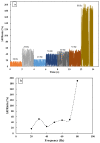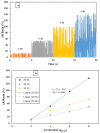Graphene/PVDF Nanocomposite-Based Accelerometer for Detection of Low Vibrations
- PMID: 36837216
- PMCID: PMC9962272
- DOI: 10.3390/ma16041586
Graphene/PVDF Nanocomposite-Based Accelerometer for Detection of Low Vibrations
Abstract
A flexible piezoresistive sensor was developed as an accelerometer based on Graphene/PVDF nanocomposite to detect low-frequency and low amplitude vibration of industrial machines, which may be caused due to misalignment, looseness of fasteners, or eccentric rotation. The sensor was structured as a cantilever beam with the proof mass at the free end. The vibration caused the proof mass to accelerate up and down, which was converted into an electrical signal. The output was recorded as the change in resistance (response percentage) with respect to the acceleration. It was found that this accelerometer has a capability of detecting acceleration up to 8 gpk-pk in the frequency range of 20 Hz to 80 Hz. The developed accelerometer has the potential to represent an alternative to the existing accelerometers due to its compactness, simplicity, and higher sensitivity for low frequency and low amplitude applications.
Keywords: accelerometer; flexible piezoresistive sensor; low-frequency; proof mass.
Conflict of interest statement
The authors declare no conflict of interest.
Figures





References
-
- Keshavarzi M., Hasani J.Y. Design and optimization of fully differential capacitive MEMS accelerometer based on surface micromachining. Microsyst. Technol. 2019;25:1369–1377. doi: 10.1007/s00542-018-4187-5. - DOI
-
- Bao L., Intille S.S. Activity Recognition from User-Annotated Acceleration Data. In: Ferscha A., Mattern F., editors. Pervasive Computing. Pervasive 2004. Lecture Notes in Computer Science, volume 3001. Springer; Berlin/Heidelberg, Germany: 2004. - DOI
-
- Schäfer H., Graeger V., Kobs R. Temperature-independent pressure sensors using polycrystalline silicon strain gauges. Sens. Actuators. 1989;17:521–527. doi: 10.1016/0250-6874(89)80040-X. - DOI
-
- Obermeier E., Kopystynski P. Polysilicon as a material for microsensor applications. Sens. Actuators A Phys. 1992;30:149–155. doi: 10.1016/0924-4247(92)80210-T. - DOI
LinkOut - more resources
Full Text Sources

